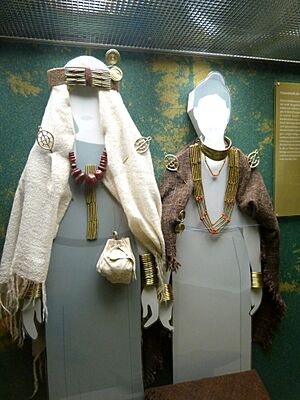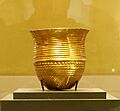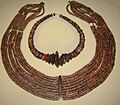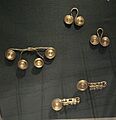Tumulus culture facts for kids
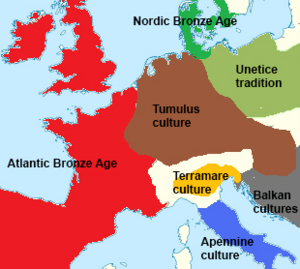 |
|
| Geographical range | Central Europe |
|---|---|
| Period | Middle Bronze Age |
| Dates | c. 1600–1200 BC |
| Preceded by | Unetice culture, Ottomány culture, Rhône culture, Mad'arovce culture, Encrusted Pottery culture |
| Followed by | Urnfield culture, Lusatian culture |
| Central European Bronze Age | |
| Late Bronze Age | |
| Ha B2/3 | 950–800 BC |
| Ha B1 | 1050–950 BC |
| Ha A2 | 1100–1050 BC |
| Ha A1 | 1200–1100 BC |
| Bz D | 1300–1200 BC |
| Middle Bronze Age | |
| Bz C2 | 1400–1300 BC |
| Bz C1 | 1500–1400 BC |
| Bz B | 1600–1500 BC |
| Early Bronze Age | |
| Bz A2 | 2000–1600 BC |
| Bz A1 | 2300–2000 BC |
The Tumulus culture was an important group of people in Central Europe during the Middle Bronze Age. This was a long time ago, from about 1600 to 1300 BC.
They were the next big culture after the Unetice culture. Their main area was where the Unetice people used to live. This included parts of modern-day Germany, the Czech Republic, Austria, Switzerland, Poland, and France. Later, the Urnfield culture followed them. Some historians think the Tumulus culture might be linked to the early Italic and Celtic groups.
Contents
What Made Them Special?
The most special thing about the Tumulus culture was how they buried their dead. They placed bodies under large mounds of earth, called tumuli or kurgans. This is how the culture got its name!
In 1902, a researcher named Paul Reinecke studied these Bronze Age burial mounds. He helped us understand the different time periods of the Tumulus culture. Even though burial mounds were used in other parts of Europe for a long time, the term "Tumulus culture" usually means the specific group from southern Germany during the Bronze Age.
Their Society and Homes
The Tumulus culture was a society of skilled warriors. They expanded their territory, moving east into the Carpathian Basin and north into areas of Poland.
Their homes were often in small villages or single farmsteads. These were usually built around strong, fortified places like hillforts. Some important fortified settlements include the Heuneburg, Bullenheimer Berg, Ehrenbürg, and Bernstorf. They built strong walls using wood, stone, and clay to protect themselves. For example, the Ehrenbürg had a huge wall that was 3.6 meters wide!
Trade and Important Objects
People of the Tumulus culture traded with groups far away. They traded with people in Scandinavia, Atlantic Europe, and the Mediterranean Sea region. They exchanged things like amber (fossilized tree resin) and metal objects.
Around 1400 BC, people in Central Europe started using weighed metal as a form of payment, almost like money. Tools for weighing metals have been found from this time.
Some experts believe that the Tumulus groups from southern Germany might have spoken an early form of a language that later became Italic and Celtic. However, other experts have different ideas about where these languages came from.
A very special find from this time is the Bronze Hand of Prêles from Switzerland. It dates back to the 16th-15th century BC. It's the oldest metal piece shaped like a human body part found in Europe! It might have been used in rituals, or perhaps it was part of a flag or even an early prosthesis (an artificial body part). It was found in a grave with other bronze items and had a gold bracelet.
Golden Hats and Calendars
Two amazing objects from the late Tumulus period (around 1400 BC) are the Golden Hat of Schifferstadt in Germany and the Avanton Gold Cone in France. These tall, cone-shaped hats were probably worn by important religious leaders.
The patterns on these hats might have been a type of calendar. They could have helped people track the sun and moon cycles. Similar gold discs found in the Czech Republic, from about 1650-1250 BC, also have patterns that might represent simpler calendars. Other special objects found in Austria and Sweden are also thought to be ancient solar calendars.
Gallery
-
Tumulus ceramics, Hagenau, France
See also
- Bernstorf fortified settlement
- Bronze hand of Prêles
- Bell Beaker culture
- Frankleben hoard
- Urnfield culture
- Nordic Bronze Age
- Bronze Age Britain
- Argaric culture
- Ottomany culture
- Vatya culture
- Wietenberg culture
- Srubnaya culture
- Mycenaean Greece
- Atlantic Bronze Age
- Terramare culture
- Apennine culture


